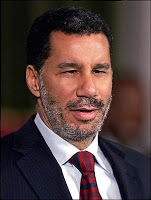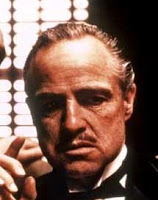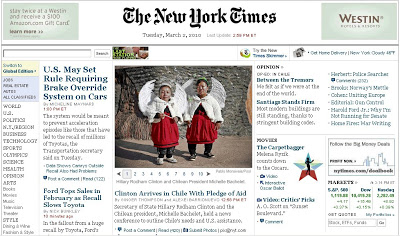
In its page-one story about David Paterson today, the NYT yet again quietly added new wrinkles to its narrative of the governor's actions in the domestic violence case at the core of his troubles -- altering yet again the timeline of events, and contradicting its own previous reporting of the case.
Today's story also moved to impose an outrageous new reportorial standard on the story -- that the governor must submit to its reporters a regular update on his plans to remain in office, or else justify its speculation that he will soon resign.
"Asked by reporters if he would still be governor on Friday, he said he would; asked if he would still be governor next week, he did not respond," the NYT reported this morning.
The NYT's aggressive but at-times careless journalism -- reflecting a seeming determination to force the governor to resign before the results of the Attorney General's investigation have been announced -- has seriously diminished what should otherwise have been an investigative triumph for the NYT.
In story after story, as The NYTPicker previously reported, the NYT has
failed to include the comments of Paterson and others accused by name of actions that could be construed as criminal behavior. It has repeated its regular insinuation that Paterson's February 7 phone call to Sherr-una Booker -- the woman at the heart of the scandal -- somehow directly resulted in her decision not to appear in court the next day, even though there has been no direct evidence yet presented to explain the connection between those two events.
This isn't to suggest that when the Attorney General issues his report, we won't learn that Paterson is indeed guilty of witness tampering, or worse. We believe Paterson should have fired his aide, David Johnson, as soon as he learned of his domestic violence history. We're also troubled by the NYT's accounts of Paterson's alleged use of intermediaries to contact the woman at the center of the most serious domestic-violence dispute involving his aide.
There's no question that the Paterson story is a legitimate one. We applaud the NYT for its aggressiveness in seeking to hold him accountable for his behavior.
But it has been clear from the NYTs first story focusing on the Sherr-una Booker case that we still know too little about what happened to form a full judgment of Paterson's actions. Too many facts are still missing, or contradict each other.
Paterson properly submitted to an independent investigation, and like everyone else, we anxiously await the results. If it documents that the governor improperly inserted himself into a legal proceeding, engaged in witness tampering or otherwise acted unethically or illegally, of course he should resign.
But we'd rather wait for the results of that investigation than be subjected to conflicting, confusing, and incomplete leaks to the NYT -- presumably from Paterson's opponents -- designed to insinuate guilt, not prove it.
And for the NYT to publish those leaks on a daily basis, without addressing the clear contradictions and omissions in the accounts, reflects an undue desire by the NYT to force Paterson to resign before the investigation is done.
That seems to us beneath the extraordinarily high journalistic standards of the NYT that have made it the best newspaper in America, if not the world.
THE CHANGING NARRATIVEIn today's page-one account, the NYT reports -- nearly 750 words into the story -- that Andrew Cuomo's investigators "have been piecing together more details" about the governor's contacts with Sherr-una Booker, the woman who accused his aide of domestic abuse last Halloween.
In this new version of events, attributed to "two people with direct knowledge of her account," Paterson had "a series of conversations with Booker in an effort to control political damage from the episode."
This statement directly contradicts the NYT's own previous reporting on the governor's actions.
As recently as Tuesday, the NYT -- attributing its information to a mix of anonymous sources and Lawrence Saftler, Booker's attorney -- had been reporting that Paterson had a single conversation with Booker, lasting about a minute.
Indeed, the NYT definitively reported -- for several days' straight, and as recently as this past Monday -- that according to Booker's lawyer, the subject of the court case did not come up in the conversation, and that Paterson "had asked if the woman was all right and reassured her that 'if you need me, I’m there for you.'”
Today's new scenario -- buried deep inside a story about the fallout from Paterson's troubles -- has Paterson speaking with Booker repeatedly, mostly discussing the possible impact of NYT stories in the works on the governor.
The NYT story doesn't indicate when the conversations took place, how long they lasted, or who initiated them -- all crucial questions that bear directly on Paterson's possible guilt.
Here's what the NYT reports today, with the new information in bold:
Two people with direct knowledge of her account said Thursday that after the Feb. 7 conversation, the governor had a series of conversations with Ms. Booker in an effort to control political damage from the episode. Around that time, reporters for The New York Times were asking questions about it. At some point during that series of conversations, Mr. Paterson mentioned the court case, according to the two people with direct knowledge.
They said that in her testimony for Mr. Cuomo’s inquiry, Ms. Booker spoke of how, among other concerns, Mr. Paterson had expressed worry about how she would portray the episode with Mr. Johnson to reporters.
It is not clear when the governor learned that she had accused Mr. Johnson of using violence against her.
In Ms. Booker’s testimony, she said that most of the governor’s conversations with her concerned ways to tamp down a possibly damaging newspaper article, according to the people who know her version of events. She also told the governor that she was annoyed because a reporter had contacted her about Mr. Johnson.
This new version of events directly contradicts the version the NYT has been reporting for days, attributed to Booker's own lawyer.
In a story last Thursday, the NYT reported:
Mr. Saftler said the conversation had nothing to do with rumors about the governor’s private life. He said, as he had on Wednesday, that the conversation lasted about a minute, that Mr. Paterson had asked if the woman was all right, and concluded by saying, “If you need me, I’m here for you.”
In other words, last week Booker's own lawyer presented one sequence of events to the NYT -- in which there was a only a single phone call between his client and the governor, with no discussion of the case -- and now, in today's NYT, "two people with direct knowledge of [Booker's] account" have presented a completely different version of them.
The fact that these two scenarios contradict each other -- meaning that one scenario simply isn't true -- isn't mentioned anywhere in today's NYT.
This contradiction strikes us as highly relevant, given that Saftler remains the NYT's sole on-the-record source of information on the governor's conversation with Booker -- and that he remains Booker's lawyer.
The NYT's ongoing coverage of the phone conversation -- or conversations -- between Booker and the governor has been the most troubling aspect of its investigation to date.
In previous stories, The NYTPicker pointed out that Saftler has been allowed to change his client's account of the phone call, without any disclosure of that change by the NYT.
The paper first quoted Booker's lawyer as having insisted that the governor called his client; later, he changed his story to say that Booker called Paterson, at the behest of an intermediary. Paterson confirmed that version. The NYT allowed Saftler to completely revise his account of the phone call, without any disclosure to readers that he had done so.
These ongoing contradictions, and the NYT's failure to focus readers' attention on them, reflects a seeming lack of concern by the NYT for the actual facts of the case. At this point, with numerous scenarios flying -- nearly all of them attributed to anonymous sources -- the NYT has failed to function effectively in making readers aware of the contradictions.
In this failure to keep its readers informed of these contradictions, the NYT has diminished its own reporting achievements on this story. It has also given careful readers reason to wonder why it seems so hell-bent on going to press with whatever latest scenario will makes David Paterson looks worse than before.


















